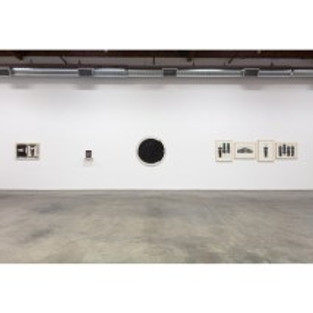
“Cock in the Box.” The Box, Los Angeles. Judith Bernstein. Photo Courtesy of The Box.
Judith Bernstein: Cock in the Box
The Box, Los Angeles
By Shana Nys Dambrot
Through March 18th
Decades before “Dick in a Box” became the greatest moment of singer Justin Timberlake’s comedy career, Cock in the Box was a remarkable 1966 drawing by feminist stalwart, the visual artist Judith Bernstein. The reasons why it has remained such a piquant work over the years include the rough, raw yet beguilingly jocular quality of its style and the contrast of its bright pastel hues with the hilarious, puffy-macho idiocy of the dick itself (which, not for nothing, bad dick drawings have become the king of graffiti and internet memes). Beyond its aesthetic wit, however, the drawing gets bluntly to several points which include but are not limited to the double standard for male as compared to female nudity as it has unfolded throughout art history — and immediately thereafter, this subject as it compares to the male to female ratio in authorship of what appears on gallery and museum walls. Also there is some written graffiti as an element in the drawing’s composition which offers a now-prescient Russia joke to go along with the dick joke. As the overall title for an exhibition at a gallery called The Box, it was clearly too good a pun to pass up. The deceptively simple piece in fact offers up many reasons to be provoked, but many more to crack a smile.
And that, in short, is Bernstein’s special thing. Individual works, especially in the realm of the smaller scale paintings and preparatory drawings of the sort gathered in this exhibition, appear simple — charcoal drawings of single pieces of hardware screws, individual words frenetically calligraphed on white grounds, gestural color-rich botanical studies — and yet in fact, contain in those limited lexicons, a great reserve of thorny topicality in commenting on gender, power, nature, and sexual politics. Her well-known signature drawings (works which contain only her repeated, muscular signature blown up to be the central focus and sole content of eponymous images) began in the 1980’s, when the male ego dominated the art world and basically just every inch of New York City. Part protest, part gesture of inherent dominance, those works and the word-drawings that followed continued to explore not only the power of language, but also the gendering of aggressive creativity. Four of Bernstein’s word-drawings (Male, Honor, More, and Voice (all 1995, charcoal on paper, 49 ¾ x 65 ¼ inches each) as well as a site-specific Judith mural on the gallery exterior, make the case for reclaiming this energetic idiom — again with a combination of power, wit, and sheer optical pleasure.

“Cock in the Box.” The Box, Los Angeles. Judith Bernstein. Screws. 1968. Charcoal on Paper. Photo Courtesy of The Box.
Likewise the screw drawings; born of anger perhaps, executed with perfect technique and classical craft, and in their frankness being as hilarious, recriminatory, and snarky as conceptual still life can. Mostly charcoal on paper, there is a never-exhibited charcoal on canvas work, Circle Screw from 1970. Like the dick drawing of fame and fortune, these undeniably phallic bits of hardware take themselves so seriously in these almost heroic presentation portraits — and are still called screws. She works too hard to make them very good drawings for their content to be simply a throw-away pun; but it is precisely the swashbuckling brandishing of her considerable skills that just makes the punch land that much harder on her target.
For those who may have had to ahem, look this up, Anthuriums are those flowering plants with red waxy heart-shaped leaves and those pale waxy mini-phallus stamen type things poking shamelessly right out of the middle of them. As botanicals go, they are not difficult to sexualize, and they especially lend themselves to a hermaphroditic visual pursuit. Also during the 1980’s Bernstein became a bit obsessed with them, executing what must be scores of oil on linen variations on their form, 18 of which are installed in a marching-order phalanx reminiscent of serial-print Warhol installations but with all the humming vibrato, optical flirtation, and emotional range of a tropical Abstract Expressionist garden in bloom. Mapplethorpe and O’Keeffe would get it, flowers are not always just flowers; and even when they are more than flowers, they are not always just vaginas.
Speaking of vaginas, the amazing masterpiece Birth of the Universe: The Voyeurs (2014, oil on canvas, 108 x 108 inches) is not only Bernstein’s most recent work in the show, but also the most awe-inspiring. It presides over the proceedings, keeping the curious cocks at bay, blocking them from the inner sanctum of its joyful, riotous, hyper-chromatic happy place. Its size is impressive, as is the consistently high-octane energy of its all-over cosmic abstraction and the architectural strength of its central image. Like a mash-up of a stained glass rosette window, a graffiti-slathered mural, and a microbial enlargement from a cellular level, the vagina may be giving birth, fending off would-be penetrators, and expelling the biota of the big bang and life as we know it all at once. And it looks gorgeous doing it.
#losangeles #feminism #losangelesartist #art #painting #onlineartmagazine #JudithBerstein #TheBoxGallery #losangelesart #contemporaryart #southerncalifornia #LosAngelesArtists #feminist #gallery #shananysdambrot #TheBoxLosAngeles #artandcake #artexhibition #ArtandCakeLA #fineart #artists #artist #mixedmedia #arts #artreview #feministart #artexhibit #ArtandCulture #exhibition #TheBox #CockintheBox #graphite #exhibit #dtla #losangelesgallery #drawing










































